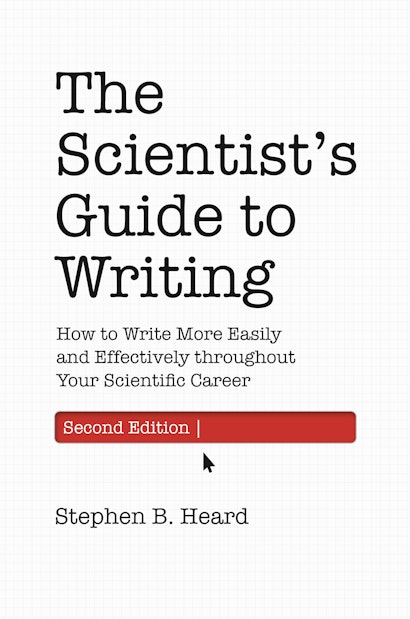In his book, A Scientist’s Guide to Writing, Stephen Heard draws on his own experience as a scientist, graduate adviser, and editor, emphasizing that the goal of all scientific writing should be absolute clarity; that good writing takes deliberate practice; and that what many scientists need are not long lists of prescriptive rules but rather direct engagement with their behaviors and attitudes when they write. He combines advice on such topics as how to generate and maintain writing momentum with practical tips on structuring a scientific paper, revising a first draft, handling citations, responding to peer reviews, managing coauthorships, and more.
What would you say is the big idea the book tries to address?
SH: Well, the big idea it addresses is simple: that scientific writing is hard for almost everyone, but that with some help, it can get easier! I know that for me, as an early-career scientist, my whole outlook changed when I figured out that writing was a skill that I could practice and develop, not just something I would sit down and do when an experiment was finished. The Scientist’s Guide to Writing distills a lot that I’ve learned about myself, and about other scientific writers, over the years.
Drilling down a little further, I think there are two major themes to the book.
The first is that the most important thing we’re trying to achieve in our writing is clarity. As scientific writers we’re not always very good at that, so I devote a lot of content to ways to achieve clearer writing: outlining, for example, and working with conventions readers expect in the structure and format of the scientific paper. I hope someone reading the book will end up with a toolbox they can apply to their writing at all scales—all the way from word choice up to the structure of a whole paper.
The second theme is that writers can benefit a lot about conscious reflection on their own behavior as they write. We know a lot about human psychology, and that knowledge gives us tools to write more quickly and efficiently (wouldn’t we all like that?). Things like procrastination, perfectionism, writer’s block—these are at least as important to scientific writers as our handling of detail in a Methods section. Probably more important! I know I’m my own worst enemy when I sit down to write, but over the years I’ve learned ways to manage my own behavior and they help a LOT. I think many other writers are like me.
Some might expect a book about writing to be dry and boring. How did you avoid this?
SH: Well, they can be! But I worked really hard to make The Scientist’s Guide engaging, and I hope even entertaining. It’s true that topic sentences, sentence structure, and the distinction between “reject” and “reject but resubmit” could be pretty dry. But I think writing can be fascinating too. Just as one example, there’s a rather weird history behind the use of active vs. passive voice in scientific writing with over 350 years of surprising twists and turns. Plus, I was able to sneak in California condors, the only Grammy Award every given for “Best Disco Song”, and a bunch of other fun things. I love it when people tell me they enjoyed reading the book.
Why was it time for a second edition?
SH: I got bored? No, just kidding! The first edition holds up really well, I think, but I saw opportunities to make it even more useful. There are lots of additions, but I’ll mention three in particular. First, there’s a new chapter on reading. We can’t write about science without reading about it, and handling the absolute firehose of new papers published in every field is a huge challenge. I’ve written about “reference reading”, “survey reading”, and “deep reading” strategies, and I think they offer real help. Second, there’s a new chapter on publication venues—on choosing among journals when it’s time to submit a paper, and about preprinting. I think this is a topic many early-career folk would like to see demystified. Finally, I’ve more than doubled the number of end-chapter Exercises. People tell me they’ve found them very useful in teaching (I use them in my own scientific-writing course!), but also that they’ve used them working through the book on their own. Of course there are tons of smaller additions, too. I hope that if you liked the first edition, you’ll love the second.
How do you see the book helping people mentor and teach writing?
SH: What’s interesting about that question is that I’ve been really surprised—pleasantly so—to see how creative people have been. When I first started writing the 1st edition, almost 10 years ago, my mental picture was, boringly, of an early-career scientist buying the book and reading it. And of course an instructor can adopt the book as a text for an undergrad or grad course in scientific writing—I very often hear from colleagues who are using the book that way. (All my own course materials are available here, by the way). But there are other, more imaginative, uses for the book that people have told me about. Some of my colleagues buy a copy of the book for every new student who joins their lab. Others “adopt” the book for the lab, and read it together in a lab meeting—covering a couple of chapters each week, with different students presenting each time. A few folks have “live-tweeted” their reading of the book, sharing their favourite insights on social media.
And if I were allowed to think outside the box a little more, why couldn’t a department adopt the book (or another writing book, of course!), not for an individual course, but for a major? Students would keep the book and refer back to it throughout their degree program, giving the program a consistent approach to teaching writing and an opportunity for each course to reinforce the last. I think our curricula would benefit if we did this with writing, and with statistics, and probably a few more things—but I’m not sure the world of academic program design is quite ready for my ideas!
What’s the most satisfying thing about writing a book like this?
SH: By far: seeing a dog-eared copy in the wild! Sometimes someone will ask me to sign a copy, and they’ll apologize that the corners are worn round and there are post-its sprinkled all through. But that’s just wonderful—it means they’ve returned to the book over and over again, and found think that have helped them. Whenever someone tells me the book has helped them write more easily, or faster, or better, my day is absolutely made!
Stephen B. Heard is professor of biology at the University of New Brunswick in Canada and associate editor of the journal American Naturalist.

